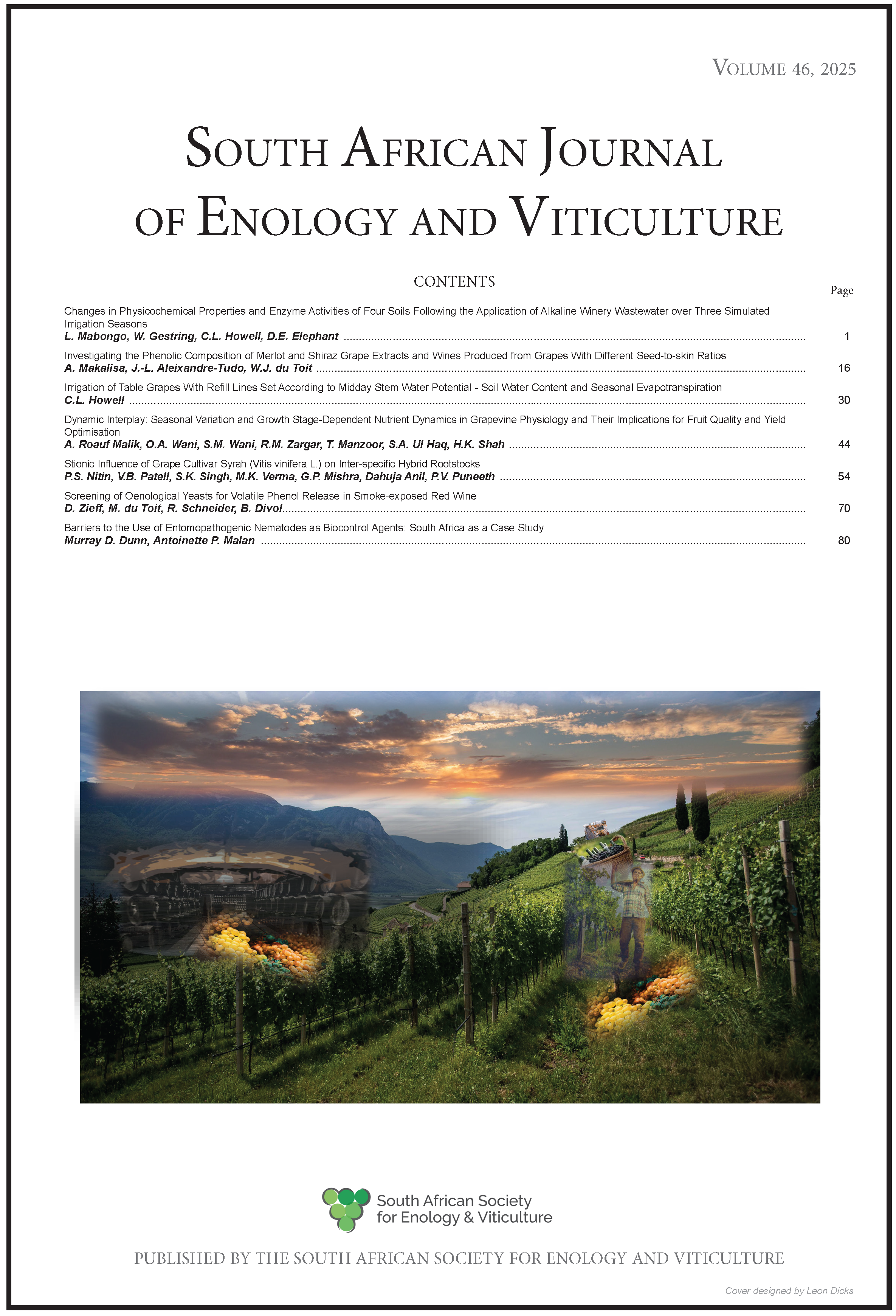Evaluation of Technological and Phenolic Maturation of Grapes and Wine Aromatic Profile under Subtropical Conditions
DOI:
https://doi.org/10.21548/46-7285Abstract
The purpose of this study was to evaluate the technological and phenolic maturation of ‘Cabernet Sauvignon’, ‘Merlot’, ‘Pinot Noir’, ‘Fiano’ and ‘Viognier’ grapes, as well as their wines sensory and volatile profiles, under subtropical conditions in southern Brazil. The experiment was conducted during the 2020/2021 and 2021/2022 growing seasons. The must physicochemical parameters analysed were pH, total soluble solids, total titratable acidity, total polyphenols, total anthocyanins, and total tannins. Volatile compounds in the wines were determined using gas chromatography (HS-SPME-GC/MS). Sensory analysis was performed using visual, olfactory and taste parameters, with quantitative assessments based on rating scales. The total soluble solids ranged from 18.1°Brix (‘Viognier’) to 19.8°Brix (‘Pinot Noir’), while titratable acidity varied from 7.40 g/L (‘Merlot’) to 9.48 g/L (‘Pinot Noir’). The grapes from all cultivars exhibited suitable parameters for technological and phenolic maturation, with distinct characteristics such as adequate pH, total soluble solids, and slightly elevated total titratable acidity. Sensory analysis of the red wines revealed profiles characterised by red fruit, earthy/animal and floral notes, with key volatile compounds such as isoamyl alcohol, phenylethyl alcohol, diethyl succinate and isoamyl acetate. The sensory profile of the white wines was related to citrus, sweet fruit and floral aromas, attributed to the presence of citronellol, β-damascenone, ethyl-2-phenylacetate and ethyl octanoate. The results of this study provide valuable insights into the characteristics of wines produced in this emerging wine region of southern Brazil, contributing to a better understanding of the region’s viticultural potential.
Downloads
Downloads
Published
Issue
Section
License
Copyright (c) 2025 South African Journal of Enology and Viticulture

This work is licensed under a Creative Commons Attribution-NonCommercial-NoDerivatives 4.0 International License.
A copyright form will be e-mailed to the corresponding author when the manuscript has been accepted for publication.
In principle, the Author agrees to the following when he/she signes the copyright agreement:
I hereby assign to the SOUTH AFRICAN SOCIETY FOR ENOLOGY AND VITICULTURE (SASEV) the copyright of the text, tables, figures, supplementary material, illustrations and other information (the Material) submitted with the manuscript to be published in SOUTH AFRICAN JOURNAL OF ENOLOGY AND VITICULTURE (SAJEV) (the "Article"). The copyright becomes effective from the date the Article has been accepted for publication in SAJEV.
This is an open access journal, and the authors and journal should be properly acknowledged, when works are cited.
Author's may use the publishers version for teaching purposes, in books, theses, dissertations, conferences and conference papers.
A copy of the authors' publishers version may also be hosted on the following websites:
- Non-commercial personal webpage or blog.
- Institutional webpage.
- Authors Institutional Repository.
The following notice should accompany such a posting on the website: This is an electronic version of an article published in SAJEV, Volume XXX, number XXX, pages XXX - XXX, DOI. Authors should also supply a hyperlink to the original paper or indicate where the original paper (www.journals.ac.za/index.php/sajev/) may be found.
Authors publishers version, affiliated with the Stellenbosch University will be automatically deposited in the University's Institutional Repository SUNScholar.
Articles as a whole, may not be re-published with another journal.
The following license applies:
Attribution CC BY-NC-ND 4.0

